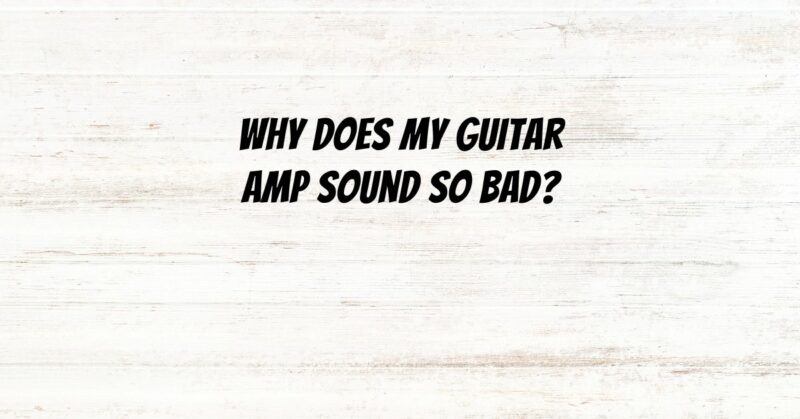As a guitarist, your amplifier is your trusted companion, shaping the tone and character of your instrument. However, there may come a time when you’re faced with the frustrating issue of your guitar amp sounding bad. Don’t worry; this comprehensive article will help you diagnose common problems and provide solutions to get your amp sounding great again.
Common Reasons Your Guitar Amp May Sound Bad
- Dirty or Faulty Tubes: Vacuum tubes (valves) are an integral part of tube amplifiers, and they can become dirty or fail over time. This can lead to a degraded and muffled sound. To address this issue, consider cleaning or replacing the tubes as needed.
- Incorrect Tube Bias: Tube biasing ensures proper operation and sound quality. If your amp’s tubes are not biased correctly, it can result in distorted or unbalanced sound. Consult your amp’s manual or seek professional help to adjust the bias settings.
- Speaker Issues: Your amp’s speaker(s) can suffer from wear and tear. If the speaker cone is damaged or torn, it can produce unwanted distortion and uneven sound. Replacing a damaged speaker can improve sound quality significantly.
- Potentiometer and Jack Issues: Over time, potentiometers (pot) and input/output jacks can become dirty or worn, leading to crackling, popping, or intermittent sound. Cleaning or replacing these components can restore proper functionality.
- Dirty Contacts on Footswitches or Effects Loop: If your amp has footswitches or an effects loop, the contacts can become dirty, resulting in signal loss or noise. Clean these contacts with contact cleaner to improve their performance.
- Faulty Wiring or Solder Joints: Loose or damaged wiring and solder joints can cause intermittent connections and affect your amp’s sound quality. Inspect the internal wiring and solder joints for any issues and repair or replace them if necessary.
- Improper EQ Settings: Sometimes, the problem lies in the EQ settings on your amp. Experiment with the bass, midrange, and treble controls to find the optimal tonal balance for your playing style and genre.
- Bad Guitar Cable or Input Jack: Faulty guitar cables or input jacks can introduce noise and degrade your guitar’s signal. Try using a different cable and make sure your guitar’s input jack is clean and secure.
- Aging Components: Electronic components in your amp, such as capacitors and resistors, can deteriorate over time, affecting the amp’s performance. An experienced technician can diagnose and replace these components if needed.
- Environmental Factors: Environmental conditions, such as high humidity or extreme temperatures, can impact your amp’s sound and performance. Store your amp in a controlled environment to minimize these effects.
Tips for Troubleshooting and Maintenance
- Read the Manual: Familiarize yourself with your amp’s manual to understand its features, controls, and maintenance recommendations.
- Visual Inspection: Carefully inspect your amp’s external and internal components for any visible issues like loose wires, damaged speakers, or worn parts.
- Consult a Technician: If you’re unsure about diagnosing or fixing the problem, it’s wise to consult a qualified amp technician. They have the expertise and tools to identify and address complex issues.
- Regular Maintenance: Maintain your amp by periodically cleaning potentiometers, input/output jacks, and contacts. Replace tubes and speakers as needed to keep your amp in top condition.
- Experiment: Don’t be afraid to experiment with different amp settings, pedals, and guitars to find the right combination for your desired sound.
Conclusion: Restoring the Brilliance of Your Guitar Amp
Your guitar amp is a vital tool for your musical expression, and when it starts to sound bad, it can be frustrating. However, with careful diagnosis and maintenance, you can address the issues causing poor sound quality and restore your amp to its former glory. Whether it’s a simple fix like cleaning dirty components or a more complex repair, taking the time to troubleshoot and maintain your amp will ensure that it continues to deliver great tone for your music.


